Running on a treadmill can be taxing on your joints, and if you’re dealing with knee discomfort, odds are you’re going to be hesitant to hop onto one of these cardio machines for a worthwhile session. Thankfully, running on a treadmill with bad knees doesn’t need to be a challenging, painful excursion day in and day out. Plenty of the best treadmills for bad knees feature comfortable, well-cushioned running decks — as well as other accommodating components — to help you ease back into working out at your full potential.
Finding an ideal treadmill for bad knees can be a different endeavor than searching for a top-performing treadmill overall. You need to keep an eye out for specific build qualities that can support your training, whether exercising around an injury or not — treadmills can cost a pretty penny, so the fewer machines you can purchase throughout your fitness journey, the better. We’ve gotten hands-on with over 20 treadmills to seek out the most comfortable workout experiences within the category. Let’s hop into our findings to help you ensure your fitness goals aren’t sidelined entirely because of a nagging joint.
The 6 Best Treadmills for Bad Knees of 2023
- Best Treadmill for Bad Knees Overall: NordicTrack Commercial 1750
- Best Budget Treadmill for Bad Knees: Horizon 7.0 AT
- Best Cushioned Treadmill for Bad Knees: Sole TT8
- Best Walking Treadmill for Bad Knees: ProForm City L6
- Best Running Treadmill for Bad Knees: Sole F63
- Best Treadmill for Bad Knees with Streaming: NordicTrack Commercial 2450
How We Tested
The BarBend team is made up of competitive athletes, certified personal trainers, and lifelong fitness enthusiasts. We’ve been walking and running on treadmills for years now and know the qualities to look for in a profile when trying to navigate a cardio program with irritated knees.
We tested and researched a number of factors to generate this cardio-focused round-up. In our process, we looked at running deck size, evaluated the underfoot cushioning, and tested the ease of speed and incline adjustments. We also looked at other helpful components such as foldable and space-saving designs, integrated apps and streaming services, as well as roller size, but the deck qualities and settings adjustments were the main driving factors in separating the best treadmills for bad knees apart from just the best treadmills.
Best Treadmill for Bad Knees Overall: NordicTrack Commercial 1750
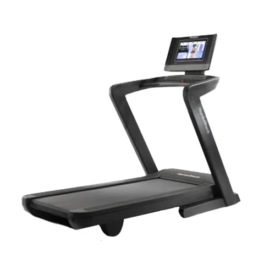
The NordicTrack Commercial 1750 is made for the tech-loving runner. This high-tech treadmill features a touchscreen monitor that can tilt and rotate, and offers automatic incline, decline, and speed adjustments based on the workout you choose.
Specs
- Price: $2,499
- Max Incline and Decline: 12% incline, -3% decline
- Max Speed: 12mph
- Weight Capacity: 300lbs
- Product Dimensions: 80” L x 38” W x 65” H
Pros
- The Commercial 1750 boasts Runners Flex cushioning that helps soften the impact on your joints at each landing and takeoff.
- A spacious 60-inch by 20-inch running deck can be accommodating for short and long strides alike.
- This NordicTrack treadmill features a swiveling 14-inch touchscreen display for on-treadmill and off-treadmill workouts through the iFit library.
Cons
- There are no pre-programmed workouts built into this treadmill, which makes the additional iFit subscription practically a requirement for operation.
- Our tester noted that initial assembly can be labor intensive and requires two people given the machine’s heavier build.
- Even with the foldable SpaceSaver design feature, the Commercial 1750 is still one of the largest treadmills on this list, which can be less than ideal for athletes living in smaller spaces.
If you’re familiar with our treadmill coverage, you’ll know that we hold the Commercial 1750 in high regard, but our favorite NordicTrack treadmill is not just a one-trick pony. We admire its effectiveness for athletes with bad knees thanks to its impressive Run Flex cushioning technology. This added feature created a supple landing in each stride during testing, which lessened the impact felt across our joints. Granted, this tech is always on with recent iterations of the machine — previous year models allowed you to toggle the feature on and off at your discretion — but it’s still a worthwhile inclusion, especially for those with joint discomfort.
We also appreciate the spacious running deck built into the Commercial 1750. The 60-inch length is enough for most stride lengths, allowing you to keep your natural plane of motion without fear of stepping off the platform in training. The 20-inch width is also a nice touch, creating a comfortable enough space for arm swings and the occasional side correction.
Of course, it’s hard to recommend a NordicTrack treadmill without mentioning the iFit library of online training classes and challenges. We appreciate this integrated service thanks to its wide variety of workouts. You do need to pay for access to the platform after a 30-day trial period, but for our money, the breadth of assortment is worth the extra monthly charge. The Commercial 1750 also features a rotating 14-inch touchscreen, which our tester appreciated when mixing on-treadmill and off-treadmill workouts within their respective regimen.
While we admire this treadmill for its in-training comfort and lessened impact on your knees, getting the machine up and running can be a challenge. Our tester noted that assembly is labor intensive, and moving the bulky 340-pound machine is a chore in itself. To help alleviate any strain across your joints before even getting to your first workout, we recommend having a helping hand at the ready when trying to add this large machine to your home gym.
Read our full NordicTrack Commercial 1750 Review.
Best Budget Treadmill for Bad Knees: Horizon 7.0 AT
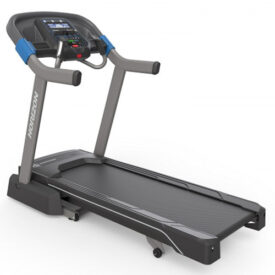
The Horizon 7.0 AT Treadmill is a durable, low-cost option for anyone looking for a quality treadmill without overspending. It features a strong motor, a wide range of speed and incline settings, and a unique three-zone cushion system.
Specs
- Price: $999
- Max Incline and Decline: 15% incline, 0% decline
- Max Speed: 12mph
- Weight Capacity: 325lbs
- Product Dimensions: 76″ L x 35″ W x 66″ H
Pros
- This 7.0 AT treadmill features Three-Zone Variable Response Cushioning, which can help with soft landings and firm takeoffs at both ends of your gait.
- QuickDial controls for the speed and incline can be great for interval training or making adjustments on the fly.
- The 7.0 AT carries an impressive lifetime warranty for both the frame and motor, making for a worthwhile purchase alongside the sub-$1,000 price tag.
Cons
- Athletes wanting a tech-riddled cardio machine should look elsewhere. The Horizon 7.0 AT is only equipped with a basic 7.25-inch LCD display.
- The 3 CHP motor is a DC motor. While this motor type can be great for fast, quiet adjustments, it cannot run for extended periods without requiring about 20 minutes of rest.
- If you want to walk at a decline to improve your knee strength, you should opt for a different profile. The Horizon 7.0 AT only supports incline adjustments.
Training with bad knees can be painful in its own right, but shelling out thousands of dollars for a lackluster treadmill? That’s a completely different sense of discomfort. Thankfully, the Horizon 7.0 AT can soothe both irritations thanks to an impressive warranty package, uniquely cushioned deck, and approachable price point. At less than $1,000, the 7.0 AT is one of the more affordable treadmills in the space.
Plus, there are no add-ons necessary to take full advantage of its training potential. While some might not enjoy this lack of integrated training apps, we found the eight pre-programmed modules (5K, Calorie, Custom, Distance, Fat Burn, Hill Climb, Manual, Target HRT) provided enough challenges in our workouts.
Our tester also appreciated the Three-Zone Variable Response Cushioning underfoot that gave each facet of their strides a nice sense of comfort. The “impact zone” toward the front of the running deck is more cushioned to create a softer landing, while the “push-off zone” near the rear is firmer for boosted takeoffs. The middle zone at the midsection of the running belt features also offers moderate cushioning, perfect for the transition between landings and takeoffs. This allowed our tester to efficiently move through workouts without wasting energy or sacrificing joint comfort.
The 7.0 AT treadmill can also be excellent for interval training thanks to the QuickDial controls at the front of the console. These pinwheel-style toggles can allow for quick speed and incline adjustments during your workouts, creating seamless transitions across the available ranges. The three CHP motor is also worthwhile thanks to its direct current nature. This motor style differs from other profiles running on alternating current, as they’re typically quieter and quicker to adjust. That said, DC motors require a cooldown after long workout sessions — we recommend 20 minutes of rest for every 45 minutes of operation.
As impressive and worthwhile as the 7.0 AT is for bad knees, we do wish this treadmill offered decline capabilities. Studies have shown that walking backwards at a decline can help strengthen the musculature surrounding your knees. (2) This can be an effective way to regain some healthiness in the joint while also promoting better resiliency in future workouts. Sadly, though, this decline feature is not present in this Horizon offering, so those wanting to take part will need to go with a different treadmill.
Read our full Horizon 7.0 AT Review.
Best Cushioned Treadmill for Bad Knees: Sole TT8
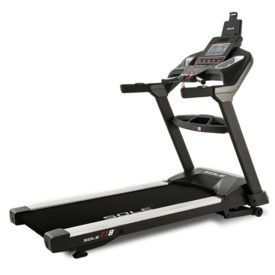
This heavy-duty treadmill features a steel framework with a 4.0 HP motor and a weight limit of 400 pounds. The three-inch rollers are ideal for runners, and the combination of incline and decline settings allows for hill work.
Specs
- Price: $2,699.99
- Max Incline and Decline: 15% incline, -6% decline
- Max Speed: 12mph
- Weight Capacity: 400lbs
- Product Dimensions: 82.5″ L x 38″ W x 66″ H
Pros
- The Sole TT8 features a Cushion Flex Whisper Deck, which the company claims can help reduce impact by up to 40 percent on your joints.
- This is one of the sturdiest treadmills we’ve tested, capable of withstanding loads of up to 400 pounds.
- This versatile treadmill has impressive settings adjustments, including a max incline of 15 percent and a max decline of six percent.
Cons
- The Sole TT8 does not feature a foldable design for added storage convenience.
- At nearly $2,700, this is one of the more expensive treadmill options in this guide.
- While the TT8 does feature a convenient tablet holder, there are no streaming capabilities baked into the 15.6-inch touchscreen display.
In testing, we found that the Sole TT8 provided the most comfortable running deck thanks to its impressive Cushion Flex Whisper technology. This, along with a two-ply belt, helped make every stride feel as if we were running on clouds, according to our tester. These components are also designed to help reduce impact by up to 40 percent across your joints, making it an easy pick for a round-up of the best treadmills for bad knees.
In addition to its plush running surface, we also enjoyed the various settings available with this Sole treadmill. The max speed of 12 miles per hour and max incline of 15 percent provided our tester with plenty of range to mix up their intensity during workouts, but the most impressive quality lay in this treadmill’s decline capabilities. The TT8 is able to reach a negative six percent decline, making it one of the best treadmills for training descents. This can be great for athletes dealing with joint issues, as regular decline training can lead to improved balance and knee strength, according to studies. (2)
The Sole TT8 is also plenty durable thanks to its reinforced framework rated for athletes up to 400 pounds. Plus, Sole backs up this impressive profile with lifetime coverage for the frame and motor, along with three years of support for the deck, parts, and wear items. One-year labor coverage is also included with the expansive warranty package, which can do a lot in offsetting the higher price tag.
The cost of this quality treadmill for bad knees isn’t the only large item across the build. The footprint takes up 21.77 square feet of space, so this isn’t the most ideal profile for athletes needing a compact machine. Additionally, the Sole TT8 doesn’t feature a foldable design, meaning you can’t regain any floor space when the treadmill is not in use. Still, for avid treadmill enthusiasts looking for the most comfortable training experience while dealing with knee discomfort, this is one quality profile worth considering.
Read our full Sole TT8 Review.
Best Walking Treadmill for Bad Knees: ProForm City L6
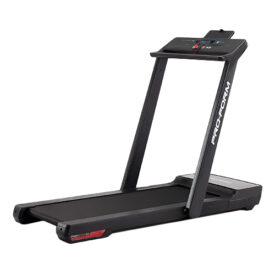
This compact treadmill is an ideal purchase for anyone tight on space who wants to reach their daily steps goal. It features a foldable frame, a 1.6 HP motor, and a top speed of eight miles per hour.
Specs
- Price: $599
- Max Incline and Decline: N/A
- Max Speed: 8mph
- Weight Capacity: 250lbs
- Product Dimensions: 70.25″ L x 29″ W x 44.5″ H
Pros
- The compact running deck and eight-mile-per-hour max speed can be great for getting your daily steps in without sacrificing a ton of space.
- The City L6 can fold up for easier storage under furniture when not in use.
- Despite the smaller frame, our tester noted a nice sense of cushioning across the ProShox system during walking sessions or light jogs.
Cons
- This City L6 treadmill cannot support moderate or high intensity runs given its smaller rollers and slower max speed.
- There’s no incline or decline adjustments available across the treadmill, which can limit your training versatility.
- The lightweight, storage-friendly design does compromise this treadmill’s sturdiness. The City L6 can only support athletes up to 250 pounds.
We understand if your nagging knees are so discomforting that you can’t muster up the energy for a full-blown run every day. If you’re looking to support your joint health with a daily dose of walking, though, we recommend this impressive City L6 profile from ProForm. We admire the comfort experienced through the ProShox cushioning system, which is doubly impressive when you take into account the machine’s sleek, compact design. The City L6 boasts a minimal footprint that, when folded onto itself, can fit easily underneath furniture and bed frames for more convenient storage when not in use.
Now, this compact silhouette does limit the engrained features of the City L6 — there’s no options for incline or decline adjustments, and the smaller rollers and motor can’t handle speeds past eight miles per hour. Despite these drawbacks, though, our tester had no issues in navigating walking sessions and light jogs atop the machine. Other treadmills in this round-up may be more capable of supporting higher intensity workouts, but at the cost of more floor space.
Additionally, the price of this walking treadmill is worthwhile. We appreciate the sub-$600 cost, which is quite the steal when you compare this ProForm profile to other machines in this round-up. Granted, those savings mean you’re giving up a burlier build and added tech features — although there is a convenient media holder for streaming purposes — but if you’re only using this silhouette for walking sessions, we think it’s worth the sacrifice.
Read our full ProForm City L6 Review.
Best Running Treadmill for Bad Knees: Sole F63
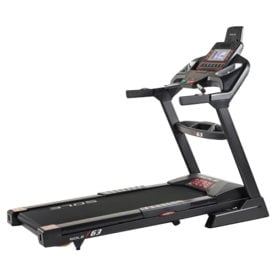
The Sole F63 is a high-quality, no-frills treadmill. The 3.0 HP motor can support up to 325 pounds, and the foldability is ideal for those tight on space.
Specs
- Price: $1,199.99
- Max Incline and Decline: 15% incline, 0% decline
- Max Speed: 12mph
- Weight Capacity: 325lbs
- Product Dimensions: 77″ L x 35″ W x 67″ H
Pros
- The Sole F63 can reach speeds up to 12 miles per hour as well as inclines of 15 percent, which can be suitable for higher-intensity running sessions.
- The 60-inch running deck is long enough to support longer running strides.
- A Cushion Flex Whisper Deck helps reduce impact by up to 40 percent across your joints, according to the brand.
Cons
- Our tester did notice some shakiness across the frame while training at high intensities.
- The integrated fan blows upward at an aggressive angle and may not be as comforting for shorter athletes.
- Athletes wanting a more intricate console may find the basic LCD display underwhelming.
The Sole F63 earns its moniker as the best running treadmill for bad knees thanks to a sturdy frame, impressive speed and incline settings, and a comfortable Cushion Flex Whisper Deck. We appreciate the brand’s inclusion of this tech in particular, as it’s designed to help reduce impact by up to 40 percent across your joints. Plus, when your knees feel up for higher intensities, the F63 is capable of supporting such training with a wide range of paces and pitches.
While our tester did notice some shakiness across the frame at high intensities for all-out sprints, they did mention that it was more of a noticeable jostle rather than a quaking sense of instability. Plus, if you do happen to notice any issues with the F63, Sole backs the profile with an impressive warranty package that includes lifetime coverage for the frame and motor, two-year coverage on the deck, parts, and wear items, as well as one-year coverage for labor.
This knee-friendly treadmill also boasts a kick release folding mechanism, integrated cup holders, and a comfort-inducing cooling fan. We did notice, though, that the cooling air is angled across the front console, meaning it may blow over the heads of shorter athletes.
We were also impressed by the 3 HP motor and 1.8-inch rollers, which combined to create a worthwhile running experience in training. Be aware, though, that the smaller roller diameter means the motor will need to work harder to achieve a full belt revolution, so wear and tear can begin to add up over extended use.
Read our full Sole F63 Review.
Best Treadmill for Bad Knees with Streaming: NordicTrack Commercial 2450
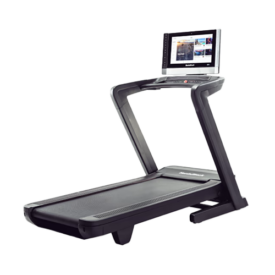
The NordicTrack 2450 is one of the most high-tech treadmills on the market. It features a 22-inch touchscreen display that can tilt to your comfort level, and rotate 360 degrees. Your purchase includes a free month of iFit, and all of your trainer-led classes offer automatic adjustments to the incline, decline, and speed settings.
Specs
- Price:$2,999
- Max Incline and Decline: 12% incline, -3% decline
- Max Speed: 12mph
- Weight Capacity: 300lbs
- Product Dimensions: 78.5” L x 35.6” W x 65” H
Pros
- The Commercial 2450 features a massive 22-inch HD touchscreen that can swivel and tilt for off-treadmill workouts as well.
- AutoAdjust technology can automatically toggle your speed and incline in accordance with your trainer-led workouts through iFit.
- This treadmill boasts a burly 3.6 CHP motor capable of supporting your training for extended periods without fail.
Cons
- At nearly $3,000, the Commercial 2450 does not fit every athlete’s budget.
- The 1.9-inch rollers may be undersized, particularly for avid runners that use their equipment day in and day out.
- You also need to budget for the extra iFit subscription, which can add roughly $40 per month to your spending.
Being able to stream videos with your treadmill can take some of the focus off your uncomfortable knee pain in training. Whether watching your favorite programs or following along to one of iFit’s trainer-led classes, we feel the NordicTrack Commercial 2450 is the best streaming-capable treadmill on the market. The impressive profile boasts a massive 22-inch HD touchscreen display that delivers cinema-quality visuals no matter your preferred programming. We also enjoy how this display tilts and swivels into optimal viewing angles, even during off-treadmill workouts.
From a build standpoint, our tester was impressed with the 3.6 CHP motor, which was capable of quick settings adjustments and extended power throughout training sessions. We do want to call out the smaller 1.9-inch rollers, though, that will require the motor to work harder for optimal belt revolutions. Avid runners or athletes wanting premium efficiency should consider treadmills with larger roller diameters.
The NordicTrack Commercial 2450 also features the brand’s AutoAdjust technology, which can be a nice convenience when taking part in iFit-powered workouts. Rather than pausing your progress to adjust the speed and incline to your trainer’s commands, the Commercial 2450 automatically keeps your running deck in sync with your instructor. This can be especially useful for athletes dealing with knee discomfort, as it takes a responsibility off their plate mid-workout and allows them to give more focus to their joints and comfort levels.
Of course, all the streaming capabilities and training-focused toggles come at a premium. The Commercial 2450 is not the most affordable treadmill at nearly $3,000. That doesn’t include the required iFit subscription, either, so be sure to account for that extra cost when budgeting. Still, though, if you can’t fathom training without a screen, this treadmill profile is tough to beat.
Read our full NordicTrack Commercial 2450 Review.
How We Choose the Best Treadmills for Bad Knees
Rather than focusing on how impactful a treadmill could be on our training intensity, we instead looked at how non-impactful each profile could be across our joints. Comfort and approachability were the main factors considered when devising this round-up, along with some other common components associated with treadmill purchases. After all, knee discomfort can come and go, but it’s more difficult to swap treadmill silhouettes in and out of your home gym.
Cushioning
Running or walking on a well-cushioned platform can make a big difference when dealing with knee discomfort. To facilitate this, we looked for treadmills boasting thick belts that could absorb impact better while pacing through workouts. While some silhouettes list their belt thickness and makeup (one-ply vs. two-ply, 1.1mm thick, etc.), others do not. So, we did our best to gather firsthand experience as much as possible when examining this factor.
Some treadmill profiles also boast added cushioning technology, furthering their shock-absorbing qualities. We made note of such features in our analysis to give you a better idea of which profiles truly take comfort into consideration across their frames.
Running Deck Dimensions
If you’re starting off from an uncomfortable state, you’ll want to keep your strides as natural as possible, meaning you don’t want to compromise your form for the sake of staying on the running platform. Most treadmills feature a running deck measuring 20 inches wide and 60 inches long. We’ve found this to be a worthwhile area for most running gaits, which allowed us to pace through training without feeling confined or in an awkward position.
We looked at each treadmill’s listed running deck dimensions and tested their actual usability wherever possible. Additionally, you’ll notice that our pick for the best walking treadmill for bad knees boasts a smaller platform than others in this list. This may be perceived as a negative by some athletes, but you need to remember that your stride length increases directly with your speed. (6) Your lower walking pace won’t need as long of a platform, hence why the shorter deck isn’t a definite concern when looking for a walking-specific treadmill.
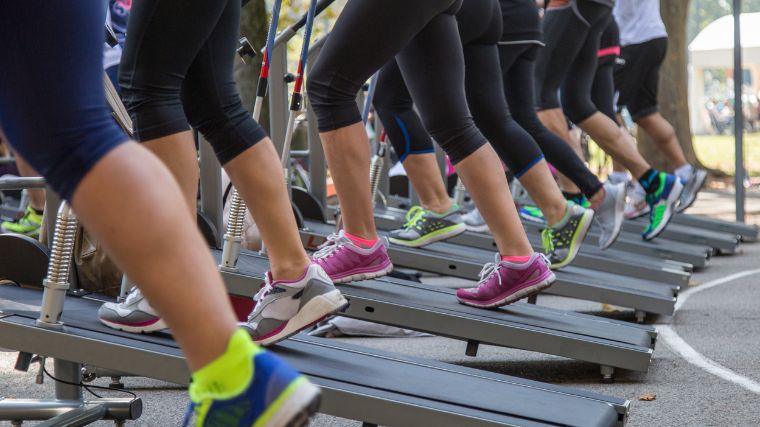
Incline and Decline Ranges
When it comes to finding an ideal treadmill for bad knees, you’re probably going to be less focused on the incline and decline ranges offered through the machine. It can be somewhat painful to train at higher pitches, after all, so these toggles are likely to be left alone as you work through your injuries. (5) That said, you’ll want to ensure your machine can facilitate quality workouts once your knees are better, so we looked for treadmills offering worthwhile ranges that can be suited for these needs post-discomfort.
Studies also show that walking backwards downhill can help strengthen your knees over time. (2) So, we tried to find treadmills that offered a decline range wherever possible. Whether you partake in this potentially joint-supporting training method is up to you, but it can be a convenient solution to have in your back pocket if you’re trying to focus on your knee rehabilitation.
Storage
Treadmills are some of the largest pieces of home gym equipment out there, so being able to conveniently house them when not in use is a plus for any athlete. When looking for profiles targeting bad knees, we looked at how spacious each silhouette was when in operation, and whether the design featured any space-saving components such as a foldable running deck.
We also tried to search for treadmills boasting a soft-folding makeup, like a hydraulic braking system, which can take the strain out of getting your running deck up and down for training. This soft-dropping design can be beneficial for athletes suffering from knee discomfort because you don’t need to worry about controlling the heavy running deck down to the floor. There’s no need to worry about performing a squat with your running deck when setting up for a session, which can eliminate another opportunity for aggravated knees in your training regimen.
Roller Size
Your roller size is directly related to how hard your treadmill needs to work during operation. Smaller rollers will need to turn at a faster pace in order to keep the belt moving at your desired speed. This extra work can be taxing on your machine’s motor over extended use and may even lead to burnout.
When curating this round-up, we looked for treadmills with rollers of at least 1.9 inches. Of course, we also took the treadmill’s motor size and quality into consideration, too, which can help offset the smaller diameters.
Workout Experience
You’re already going into your treadmill session with discomfort and irritability — why enhance those feelings with a lack of training variety or other conveniences? We looked at how accommodating each treadmill was during workouts through a slew of categories. Was there an available app integration that allowed for versatile training? Could the console support streaming services that allowed us to watch along with our favorite programs during paces? Were there utilitarian conveniences like media and water bottle holders within reach? All played a part in our rankings as we tried to deliver picks that could keep spirits high in less-than-desirable circumstances.
Benefits of Treadmills for Bad Knees
As intimidating as it may seem, using a treadmill while dealing with knee discomfort can actually be a boost to your overall well-being. These feature-rich machines can be great for keeping active throughout the irritation while also supporting your physique for fewer aches and pains in the future.
Comfort
Treadmills that cater to athletes with bad knees can often showcase an added emphasis on in-training comfort. These machines do so by featuring thicker, shock absorbent running belts. Some may also feature cushion-enhancing technology designed to further lessen the impact you experience across your joints.
We can’t say that these cushioning features will eliminate all knee pain during your training sessions, but they can be a nice touch underfoot, especially when compared to other, more rigid running platforms seen in the equipment category.
Improved Balance
Walking on a treadmill can also be a great way to improve your balance, according to studies. (2) Having a greater sense of balance in your daily life can help you prevent errant falls and unnecessary strain across your joints. This can be especially beneficial for older athletes as well. (3)
Injury Prevention
Treadmills can be an excellent tool for strengthening the muscles around your knees. (1) Working these muscles while dealing with knee pain can be challenging at times, but the end results can leave you with more supported joints overall. This can lead to fewer injuries in the future and greater improvement in your performance day in and day out. As with any workout program, though, your results are influenced by your dedication to the routine — you’ll only reap the perks if you stick with your training.
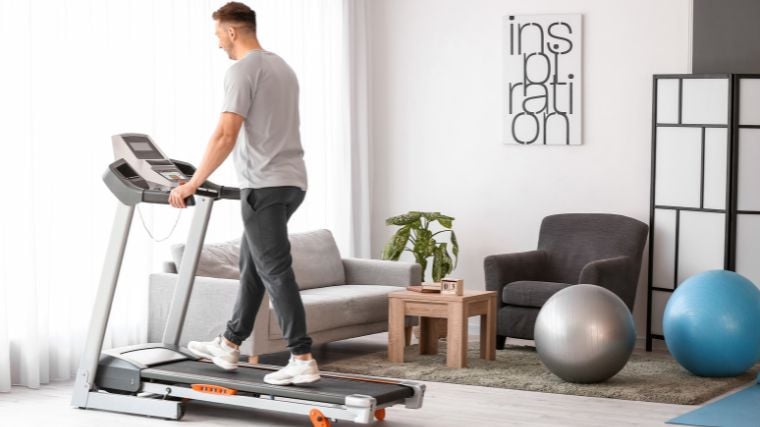
How to Use a Treadmill with Bad Knees
Because of your apparent joint discomfort, walking or running on a treadmill with bad knees is a little different than your normal, fully-healthy strides. After all, you don’t want to irritate your joints even further by pushing your limits too far in a given exercise. Below are a few quick tips to help ensure your training sessions remain as comfortable and efficient as possible.
Warm Up Before Training
Going into a treadmill session cold can be a prime opportunity for further joint aggravation. So, to help your knees ease into the workout, it’s important to warm up and stretch before your day’s training circuit. Take roughly 10 to 15 minutes to get your body warmed up for your run or walk, and be sure to put some extra focus on activating your knees. This can be done in multiple fashions — from a full-blown dynamic warm-up, to quick foam rolling sessions, and more.
Avoid Excessive Inclines and Speeds
While some pitch moderation and uptempo pacing can be beneficial for strengthening your bad knees, you don’t want to force your body into unnatural stances too quickly when dealing with discomfort. Inclines between 10 and 12 percent can be stressful across the joints more often than not, creating an added sense of strain that could stall your progress overall. It’s important to listen to your body as you work through your recovery, so be sure to set your running platform at an incline that gives you some sense of challenge without completely throttling your already aching knees.
In terms of speed, your pace can impact your stride length as well as your impact on the platform itself. (6) You’ll be pushing off the running deck with more force (and subsequently landing in the same fashion) if you’re trying to keep up with a quicker speed setting. So, we recommend taking your workouts to a cruising pace at first, adjusting your tempo in-tune with how you feel on a given day.
Wear Appropriate Footwear
You don’t need to solely rely on your treadmill’s running deck when it comes to creating a well-cushioned stride. Your running shoes can make just as much an impact (pun intended) when it comes to creating a comfortable training setup. Be sure to pair your cardio training to footwear that matches your gait with proper levels of support and stability.
It can also be helpful to go with running shoes featuring a comfortable upper and lacing structure. Finally, make sure there’s enough underfoot cushioning across the midsole to make every step as cozy as possible — you don’t want to have a rigid, brick-like sensation in your landings when trying to keep joint impact as low as possible.
Listen to Your Body
Finally, the one person that best understands how your knees feel in the throes of a workout … is you. Be sure to listen to your body before, during, and after your treadmill sessions, taking necessary breaks and pauses when necessary. Your knees will tell you when they’ve had enough and when they need a rest, so be sure to listen for these cues when trying to manage your pain and training schedule in tandem.
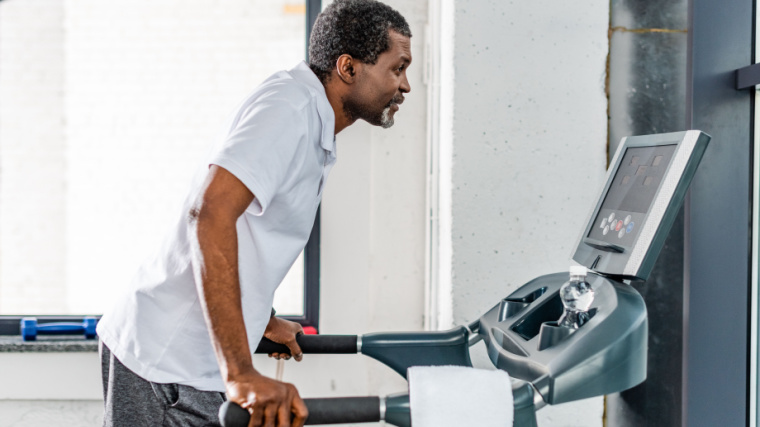
How to Choose a Treadmill for Bad Knees
If you have knee discomfort and want to elevate your training with a worthwhile treadmill, there are a few components to consider. Below are some factors we recommend looking into as you inquire about a treadmill for bad knees.
Running Deck
Most worthwhile running decks will measure 20 inches wide and 60 inches long. These are good dimensions to opt for, as they can cater to most walking and running strides. Shorter running platforms may be acceptable for walking disciplines, but they could be too confined for workouts at higher tempos. Taller athletes may also want to explore longer running decks to better facilitate their longer gaits.
You also want to look at the actual makeup of your treadmill’s running deck, as this can be greatly influential on your overall comfort during training. Thicker belts of two-ply and three-ply materials can be better at absorbing the shock and impact of each foot strike, which helps lessen the energy transfer you experience in your joints. Other cushioning technologies can be present in the build, too, to help dampen the shock felt across your knees. Each brand has its own marketing terms for such features, though, so be sure to read through the product page for added detail on the components.
Available Settings
If you’re dealing with nagging knees, you’re less likely to be pushing your workouts to extreme heights and paces. If you’re looking for a treadmill solely for knee rehabilitation, you can get away with less versatile machines offering lower incline and speed ranges. If you’re searching for a worthwhile treadmill to support your training pre-, mid-, and post-irritation, be sure to find a profile that offers your preferred settings.
Most quality silhouettes, like those featured in this round-up, will be able to reach speeds up to 12 miles per hour, as well as inclines of up to 15 percent. You can also opt for a treadmill that supports decline settings, which may be a worthwhile discipline to explore when trying to strengthen your knees. Studies have indicated that regularly walking backwards at a decline can help improve your balance and stability, lending itself to stronger joints and musculature over regular practice. (2)
Roller Size
Your rollers dictate how efficient your running belt moves in a single revolution. The larger the rollers are across your treadmill build, the less energy your machine needs to turn that belt. This can help preserve the effectiveness and efficiency of your treadmill motor over time, especially when it comes to tackling longer workouts. If your treadmill has rollers featuring smaller diameters, they could tire out more quickly given the faster speeds they need to travel at for proper belt revolutions.
In our research, we’ve found that rollers over two inches in diameter can withstand extended use more so than rollers of smaller stature. Some profiles may feature 1.9-inch rollers, but oftentimes offset this technology with more durable, high-quality motors. Be sure to check out your treadmill’s technical specifications prior to purchase — if the rollers are smaller than two inches, make sure they’re supported by a well-built motor of at least three CHP (constant horsepower) to facilitate more rigorous use.
Price
Lastly, it’s important to consider the actual cost of treadmills when looking for a silhouette suitable for your bad knees. Prices can range from budget-friendly profiles under $1,000, to luxury-riddled silhouettes reaching five-figure totals. The treadmills we’ve dubbed as worthwhile for athletes suffering from knee issues carry price tags between roughly $600 and $3,000. Cheaper profiles may suit your budget more, but may not offer convenient features like integrated apps, streaming capabilities, and versatile speed and incline settings. Think about how much you’re willing to invest in your home gym layout before ultimately deciding on a profile.
It’s also important to remember that many treadmills also require a monthly subscription to a supporting online training program, at least if you want to use the machine to its highest potential. Prices for these services typically range from $30 to $50 monthly, although some brands may offer discounts for extended membership packages. So, if you sign up immediately for year-long coverage or more, you could save a few dollars in the long run.
Final Word
The best treadmills for bad knees emphasize comfort and approachability rather than training intensity. This focused approach to workouts can help you maintain progress as you work through discomfort, and many of the profiles also have enough bells and whistles to make those post-injury sessions enjoyable, too.
Walking and running on a treadmill has also been shown to be a great way to strengthen your knees and lower body overall. (1) Practicing in this discipline can help set yourself up for less irritation and joint discomfort in the long run, leaving you with a healthier, sturdier frame of tackling all your fitness desires. We know that training around a potential injury is never an enjoyable challenge, but if you want to make the most of these workouts, these are the treadmill profiles we recommend.
FAQs
Can you use a treadmill if you have bad knees?
Yes, you can still train with a treadmill if you suffer from knee discomfort, albeit with a few precautions. For one, training at a heightened incline can cause your knees to bend at a more unnatural angle, which can lead to further aggravation. The same can be said for working out at high intensities when dealing with nagging joints. The best way to use a treadmill with bad knees is by employing a proper warm-up before training, wearing the appropriate footwear, and setting the machine at a comfortable speed and incline.
What is the best incline on a treadmill for bad knees?
If you’re dealing with knee pain when walking or running, the best incline to set your treadmill is subjective. Be sure to find an appropriate pitch that keeps your joints comfortable with every stride. That said, researchers have found that operating a treadmill between inclines of zero and three percent has shown to provide positive results. (4) This is due to the added stress placed on the glutes and hamstrings instead of the joint itself.
Which treadmill is best for bad knees?
The best treadmill for bad knees depends on a number of factors, including your budget, and fitness goals. In our opinion, the NordicTrack Commercial 1750 is the most ideal profile for athletes with bad knees thanks to its comfortable, well-cushioned deck and versatile range of speeds and inclines. Plus, the NordicTrack Commercial 1750 is integrated with iFit, which can give you access to over 17,000 fitness classes and challenges for a fresh, engaging workout experience time and time again.
How do you protect your knees on a treadmill?
You can protect your knees and joints in a number of ways when taking part in a treadmill workout. One of the most beneficial precautions you can take is by employing a proper warm-up before the training even begins. This can get your joints and musculature active and firing before the stress begins to take hold. Additionally, wearing the proper running shoes with ample cushioning and support can help lessen the impact felt across the area during landings and takeoffs.
You can also pair your knee safety to the machine itself by choosing a treadmill with well-cushioned running decks that are long enough to support your natural gait. These features can help create a stable, comfortable experience underfoot by absorbing the shock of your strides and transferring the energy away from your joints.
References
- Alghadir, A. H., Anwer, S., Sarkar, B., Paul, A. K., & Anwar, D. (2019, April 9). Effect of 6-week retro or forward walking program on pain, functional disability, quadriceps muscle strength, and performance in individuals with knee osteoarthritis: A randomized controlled trial (retro-walking trial) – BMC musculoskeletal disorders. BioMed Central. https://bmcmusculoskeletdisord.biomedcentral.com/articles/10.1186/s12891-019-2537-9
- Cha, H.-G., Kim, T.-H., & Kim, M.-K. (2016). Therapeutic efficacy of walking backward and forward on a slope in normal adults. Journal of Physical Therapy Science, 28(6), 1901–1903. https://www.ncbi.nlm.nih.gov/pmc/articles/PMC4932084/
- Pirouzi, S., Motealleh, A. R., Fallahzadeh, F., & Fallahzadeh, M. A. (2014, November). Effectiveness of treadmill training on balance control in elderly people: A randomized controlled clinical trial. Iranian journal of medical sciences. https://www.ncbi.nlm.nih.gov/pmc/articles/PMC4242992/
- Plancher, K. (2021, May 10). Protect your knees while running on the Treadmill. Plancher Orthopaedics & Sports Medicine. https://plancherortho.com/protect-your-knees-while-running-on-the-treadmill/
- Tarniţă, D., Petcu, A. I., & Dumitru, N. (2020). Influences of treadmill speed and incline angle on the kinematics of the normal, osteoarthritic and prosthetic human knee. Romanian Journal of Morphology and Embryology, 61(1), 199–208.
- van Oeveren, B. T., de Ruiter, C. J., Beek, P. J., & van Dieën, J. H. (2017). Optimal stride frequencies in running at different speeds. PLoS One, 12(10). https://www.ncbi.nlm.nih.gov/pmc/articles/PMC5653196/
The post The 6 Best Treadmills for Bad Knees of 2023 appeared first on BarBend.
